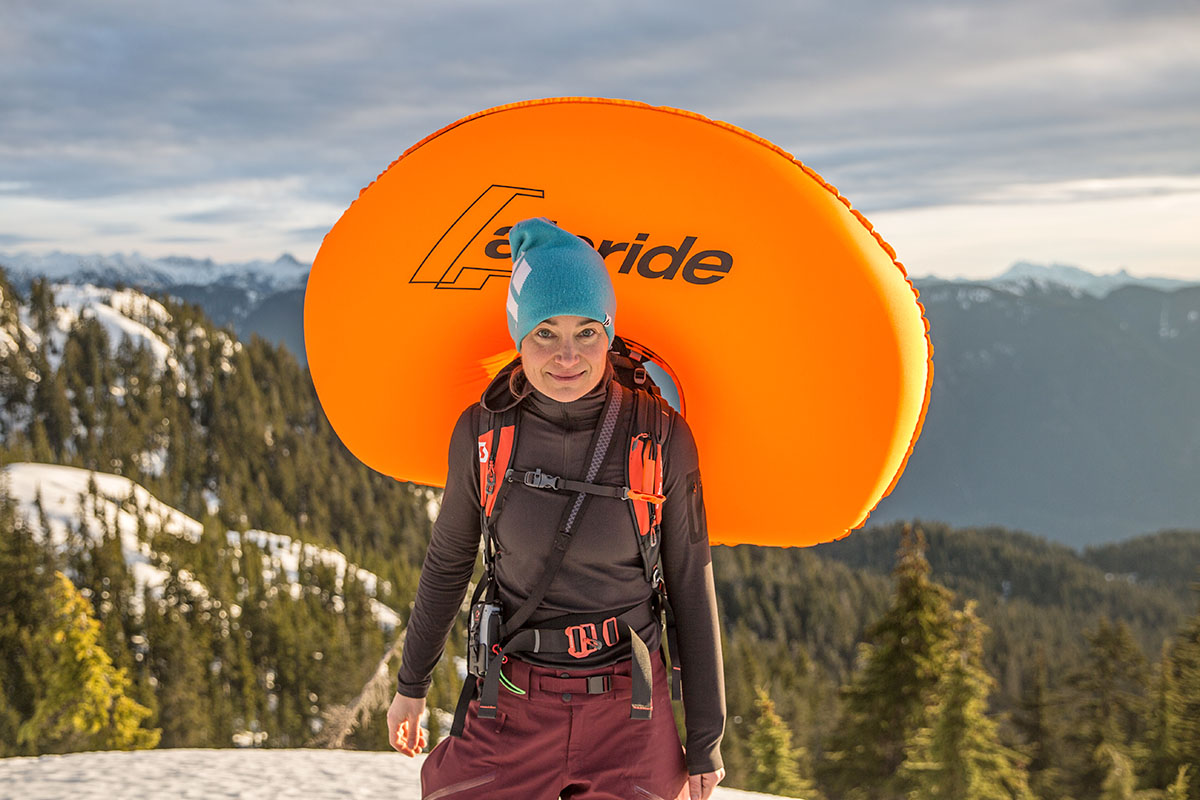
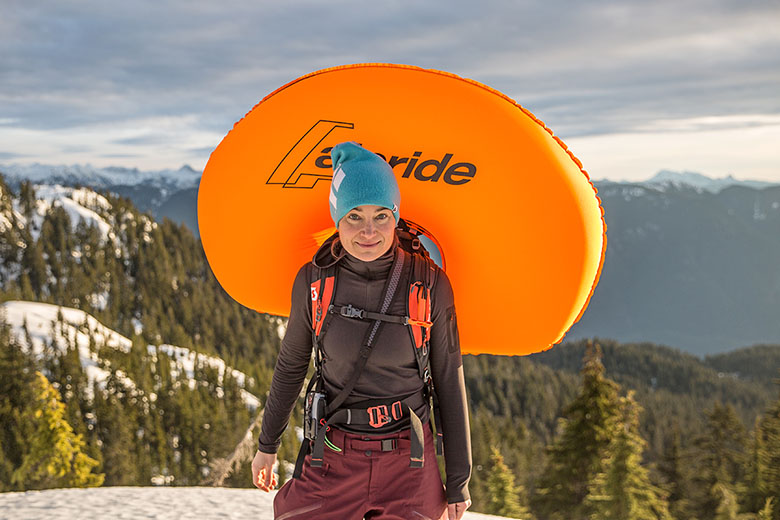
For experienced skiers and snowboarders venturing into avalanche terrain, an airbag pack can provide an extra boost in safety. These systems function by inflating an airbag to about 150 liters via compressed air (or gas) or an electric fan, which help the user stay on the surface of the snow in the event of a slide. Take note that these are not a substitute for avalanche safety gear (beacon, shovel, and probe), but rather an addition to your kit. Below, we’ve compiled a list of the best avalanche airbags for the 2024 season, including entry-level canister designs, premium fan-powered systems, and ultralight models. For more information, check out our comparison table and buying advice below the picks.
**Disclaimer: There are inherent risks to traveling in avalanche terrain. We do not condone the use of an airbag pack—or any avalanche safety tools—without proper education. Visit AIARE’s website to learn more and sign up for a Level 1 avalanche class.
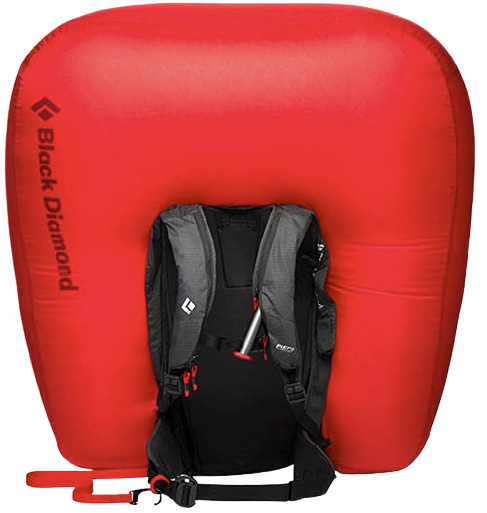 Category: Electric fan (battery)
Category: Electric fan (battery)
Weight: 6 lb. 7 oz.
Capacities: 10, 25, 35L
What we like: A lightweight battery-powered fan and modular design.
What we don’t: Expensive and the airbag compartment has a tendency to come unzipped.
Black Diamond’s JetForce series has gone through many iterations over the years, and the Pro is their best effort yet. Developed in collaboration with Pieps, the latest variation of their fan-based system is truly impressive: It sets a new weight standard for electric designs, offers multiple deployments on one charge, and includes Bluetooth connectivity for updates and to personalize your settings. The pack itself is well-designed, with easy access to gear, a secure fit, and valuable features like a helmet holder, hipbelt stash pocket, and diagonal ski carry that doesn’t interfere with airbag deployment. And perhaps the most eye-catching news: Black Diamond’s modular design means you can swap out “Boosters” (which come in 10, 25, and 35L sizes and a 25L splitboard option), giving you maximum versatility for all manner of snow missions.
Compared to canister designs, electric-fan-powered airbags offer a lot of convenience—they’re rechargeable, travel friendly, and allow for multiple deployments—but the JetForce Pro is far from the only good option. Supercapacitor-powered systems are the headlining news for the 2024 season, including recent innovations like Alpride E2 and Litric. Like the JetForce Pro’s unit, these systems check in around 2.5 pounds, but they’re more compact, can be swapped between compatible packs, and are generally a bit less expensive. We have yet to test either supercapacitor system (they’re still in their infancy), but they’re undeniably the new norm in avalanche safety. But for the time being, the JetForce Pro is still the most time-tested and reliable electric airbag system, making it our top choice for the season. And keep in mind that Pieps offers a very similar design (their JetForce BT) with just a few slight—and mostly aesthetic—deviations... Read in-depth review
See the Black Diamond JetForce Pro 25L
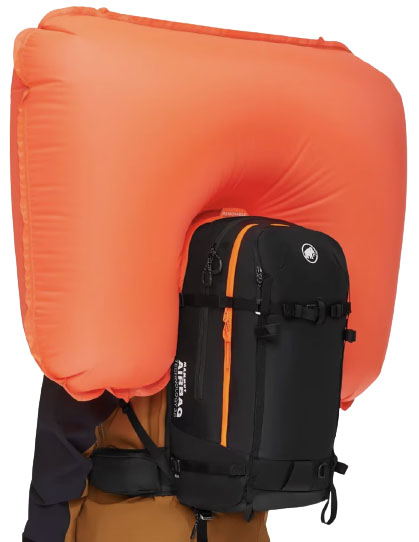 Category: Canister (compressed air)
Category: Canister (compressed air)
Weight: 5 lb. 12.6 oz.
Capacities: 35, 45L
What we like: Affordable and reliable canister system; airbag unit is removable.
What we don’t: Electric systems are a bit more user-friendly.
Electric fan airbags might be the wave of the future, but there’s still a lot to like about canister-powered designs. Mammut’s Pro 35 Removable Airbag 3.0 is an indisputable leader in this category for its mix of performance, capacity, and features. The 35-liter size is versatile for anything from day tours to extended trips, a full rear zip makes it easy to access gear, and the internal aluminum frame does a great job distributing the weight of a heavy load. But the main event here is Mammut's Removable Airbag System 3.0 (RAS), a ubiquitous unit that is compatible with various packs from brands like Jones, Dakine, Highmark, and more. It all adds up to a great two-in-one deal: You get a high-quality ski pack and versatile airbag unit that can easily be removed or used elsewhere—all for $1,005 ($780 for the airbag and pack, plus $225 for Mammut's air canister).
But as we touched on above and detail further in our buying advice below, there are a fair number of downsides to canister designs. Namely, canisters are difficult to travel with, require refilling after each use, and can only be deployed once per fill. But many will appreciate the simple mechanical system that doesn’t use complex wiring or technology, and at 5 pounds 12.6 ounces (this spec includes the 1.5-lb. canister), the Pro 35 is noticeably lighter than the JetForce Pro above (and about $500 cheaper). All in all, if you’re set on a canister airbag, Mammut’s time-tested Removable Airbag collection is a great place to land, and you won’t be disappointed with the Pro’s organization and comfort.
See the Mammut Pro 35 Removable Airbag 3.0
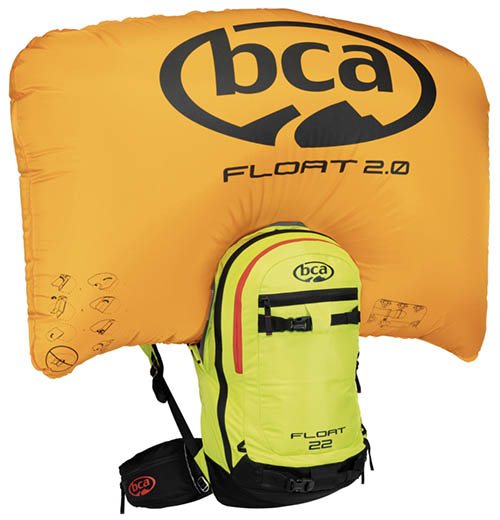 Category: Canister (compressed air)
Category: Canister (compressed air)
Weight: 6 lb. 2.1 oz.
Capacities: 12, 22, 32, 42L
What we like: Great price and BCA canisters can be filled all over the world.
What we don’t: Airbag unit is poorly placed; pack comes in just one size.
Backcountry Access (BCA) is a leader in snow safety, and their Float 2.0 is one of the most time-tested designs on the market. Both reliable and affordable, the BCA Float 2.0’s simple mechanical system uses a canister of compressed air to deploy the airbag (like the Mammut above), and it's priced for considerably less than the other packs here. The 22-liter model is well-designed and features hydration compatibility, straps for both ski and snowboard carry, a dedicated avy tool pocket, hipbelt pockets, and a plush molded backpanel. You can also bump up to the 32- and 42-liter versions for more adjustability, support, and features. And more than any other company, BCA makes their canisters easy to use, with over 300 authorized refill locations all around the world.
The Float used to be one of the top airbags on the market, but recent innovations in both electric fan and canister designs have made it a little long in the tooth. The airbag unit isn’t particularly light at 2 pounds 12 ounces and—unlike the interchangeable systems here—can’t be removed and used in another backpack. Further, while many airbag packs are available in two sizes (the BD above comes in S/M and M/L while the Ortovox below comes in men's and women's), the Float packs are one-size-fits-most. Finally, with the bulky airbag unit at the top of the pack, we’ve found it very hard to maximize space. But these shortcomings are minor for those that only plan to use their airbag pack a few days each year, making the BCA Float 22 2.0 our top budget pick for the 2024 season.
See the Backcountry Access Float 22 2.0
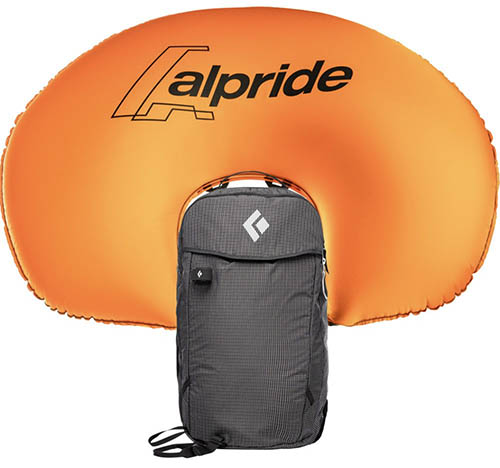 Category: Canister (compressed gas)
Category: Canister (compressed gas)
Weight: 4 lb. 6 oz.
Capacity: 26L
What we like: Ultralight without compromising too much in capacity and features.
What we don’t: One deployment per pull and each pull will cost you $70; not travel friendly.
Most packs here fall in the 5- to 7-pound range, with the airbag units taking up nearly half of the total weight (often about 2.5 lb.). But for those looking for the most streamlined option, Black Diamond’s JetForce UL stands out with its impressively light 4-pound 6-ounce build. This weight savings is primarily achieved thanks to the Alpride 2.0 airbag, which utilizes smaller cartridges of compressed argon and CO2. At only a pound and a half, the 2.0 is by far the lightest airbag unit here, and its simple mechanical (read: non-electric) design makes it durable and easy to maintain. Finally, the 26-liter pack—which can also be used on its own thanks to the removable airbag system—does a nice job balancing weight with a good array of features, including a dedicated avy-tool pocket, helmet holder, internal accessory pocket, and ski and ice-tool attachments.
What are the downsides of the ultralight build? Most importantly, like the Mammut and BCA above, you only get one deployment per pull, and unlike compressed air, gas cartridges cannot be refilled and will run you about $70 per set. In other words, despite its $900 price tag (add $70 for the cartridges) the JetForce UL is the most expensive per pull of any pack here. In addition, the BD’s pack materials are noticeably thin, and you’ll want to exercise caution particularly around sharp objects like ice tools, snow saws, or even your ski edges. As such, it lacks the versatility of the options above and is best for those that are willing to make compromises to trim off a couple pounds. Finally, it’s worth noting that the JetForce UL has been discontinued (but is still widely available at a discounted price); for something a little different, check out Ortovox’s new Litric Zero 27 ($1,200), a supercapacitor-powered design that tips the scales at just 4 pounds 5.5 ounces.
See the Black Diamond JetForce UL
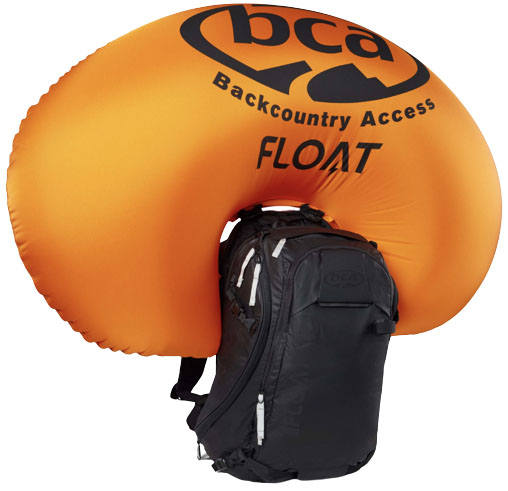 Category: Electric fan (supercapacitor)
Category: Electric fan (supercapacitor)
Weight: 6 lb. 2.5 oz.
Capacities: 25, 35, 45L
What we like: A durable workhorse with modern Alpride E2 technology.
What we don’t: Supercapacitor-powered airbags are pricier than canister models.
“Supercapacitor” is the airbag buzzword of the 2024 season, with Alpride E2 and Litric technologies taking the market by storm. Even BCA—which until now has been a staunch devotee of canister-powered airbags—has turned the corner with its Float E2 pack. And while we have yet to test the modernized Float design, all signs are positive: In true BCA style, the pack is a reliable workhorse, with robust 420-denier waterproof coated nylon, burly zippers, and aluminum hardware. There’s also no shortage of storage—the Float 35 features top, side, and hipbelt pockets, a large clamshell zipper, and a stash at the back for a hydration reservoir, radios, and more.
We won’t get too deep into the nitty gritty of supercapacitors, but the long and short is that they’re relatively small and lightweight, offer easy practice deployment, require minimal charging, and are a breeze to travel with (you can’t fly with compressed gas/air, and some lithium-ion batteries are considered too large for checked bags). And the Alpride E2 is the best iteration yet: It’s significantly more streamlined than the E1 (40% smaller and 4.9 oz. lighter), features an LCD screen to display battery levels, and offers faster charging via USB-C. As far as BCA’s adaptation goes, we think it’s one of the best Alpride E2 packs on the market—and one of the best-priced, too. It’s also worth noting that the pack comes in two sizes and three capacities, allowing you to tailor your choice based on your style of backcountry (or sidecountry) skiing.
See the BCA Float E2-35
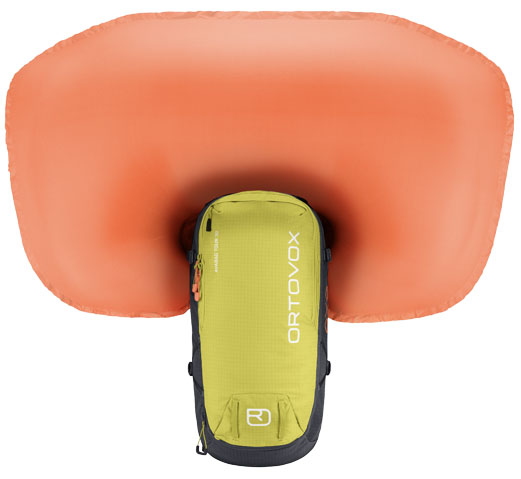 Category: Electric fan (supercapacitor)
Category: Electric fan (supercapacitor)
Weight: 5 lb. 5 oz.
Capacities: 30, 40L
What we like: An intriguing supercapacitor design from two of the best innovators in the business.
What we don’t: Not time tested and hard to find at the time of writing.
A collaboration between industry-giants Arc’teryx and Ortovox, the new Litric system gives the Alpride E2 a run for its money as the best supercapacitor airbag tech out there. Arc’teryx has yet to put their Micon Litric packs on the market at the time of writing, but Ortovox has a wide range of Litric-compatible designs, including the Tour 30 here. Similar to the JetForce Pro above, the Tour has a base and zip-on design that allow you to customize your pack for the ideal mix of features and volume (a 40L Zip is also available). The Tour collection is the best all-around touring design, but hard-charging skiers might prefer the Freeride base, which features a more body-hugging backpanel that’s also compatible with Ortovox’s Clasp spine protector.
Like the Alpride E2, Litric uses a supercapacitor to power the fan, meaning no travel limitations or hassle with cartridge refills, and no bulky and heavy batteries. Both systems weigh around 2.5 pounds and are similarly sized; the main distinction is that the Litric tops off the supercapacitors using a rechargeable lithium-ion battery, while the Alpride employs two AAs. We have yet to test either design—that’ll change this winter—but the innovations definitely offer a significant boost in convenience and useability, making airbags easier to say “yes” to than ever (as long as you’re able to pay the price). In no uncertain terms, supercapacitors seem to be the future of avalanche safety, and we’re excited to see how the market evolves from here.
See the Ortovox Avabag Litric Tour 30 See the Ortovox Avabag Litric Tour 28S
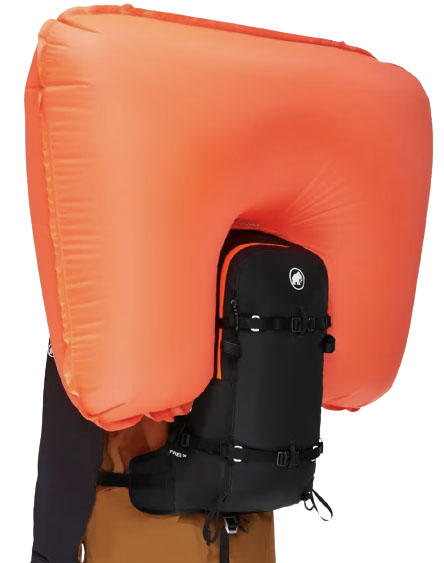 Category: Canister (compressed air)
Category: Canister (compressed air)
Weight: 4 lb. 14.5 oz.
Capacities: 15 (Vest), 22, 28L
What we like: Premium freeride backpack with a versatile airbag system.
What we don’t: Only comes in one size.
Mammut’s Pro above is arguably their most versatile model, but those who access terrain via chairlift, Sno-Cat, sled, or helicopter will want to take a closer look at their Free series. The Free 22 here (which includes the same Removable Airbag System 3.0 as the Pro) offers just enough capacity for downhill-oriented skiers while prioritizing a low weight and close-to-body feel. And all of the requisite features are still there, including a fleece-lined goggle pocket, dedicated safety tool pocket, top and backpanel access to the main compartment, and multiple configurations for ski and snowboard carry. For a premium freeride-specific airbag pack that checks in at a relatively low weight and price, the Mammut Free 22 Airbag is well worth a closer look.
As we mentioned above, one of the strongsuits of Mamut’s RAS is the ability to swap it between compatible backpacks. If you already own the airbag, you can purchase the Free 22 backpack (“airbag ready”) separately for $240. It’s worth noting, however, that the backpack only comes in one size and no separate option for women, which isn’t great news for particularly large or small users. Serious backcountry skiers will also want to check out the Free Vest 15 Removable Airbag 3.0, which comes in two sizes and offers an even more streamlined fit that won’t get in the way of your powder turns. Mammut makes one of the best canister-powered airbags in the game; if that’s the way you’ve decided to go, the Free 22 is a wonderfully minimalist option.
See the Mammut Free 22 Removable Airbag 3.0
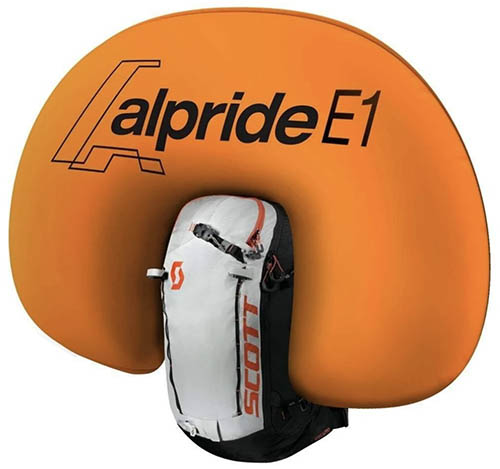 Category: Electric fan (supercapacitor)
Category: Electric fan (supercapacitor)
Weight: 5 lb. 14.2 oz.
Capacities: 22, 30, 40L
What we like: Previous-gen tech means the Scott is more affordable than the competition.
What we don’t: Alpride's E1 is heavier and bulkier than the E2; webbing hipbelt provides minimal support.
One of the longest-standing designs on the market, the Scott Patrol E1 30 features the Alpride E1, the first-gen version of the supercapacitor-powered unit used in the Float E2-35 above. To review, this system is fully electric and rechargeable via USB—or two AA batteries in the field—saving you time and money (no need to refill your canisters) and allowing you unlimited practice deployments. The E1 isn’t quite as lightweight and streamlined as the E2 and lacks upscale features like a battery life display and USB-C recharging, but it’s nevertheless a solid offering for a decent savings.
Our main gripe with the Scott Patrol is the backpack itself: Access to the main compartment is limited by a relatively short zipper, which offers significantly less convenience than the Soelden’s generous U-shaped opening. Second, the Patrol’s simple webbing waistbelt provides minimal support and does not come with the convenient stash pocket seen on the Soelden. It’s worth mentioning that Scott has recently released the updated Patrol E2 30 (changes include the Alpride E2 unit, more supportive waistbelt, and $1,350 price point), but we’ve kept the first-gen version here as a lower-priced supercapacitor-powered option. The good news is that both models come in two sizes and three capacities, so you can tailor your pack to best suit your needs... Read in-depth review
See the Scott Patrol E1 30
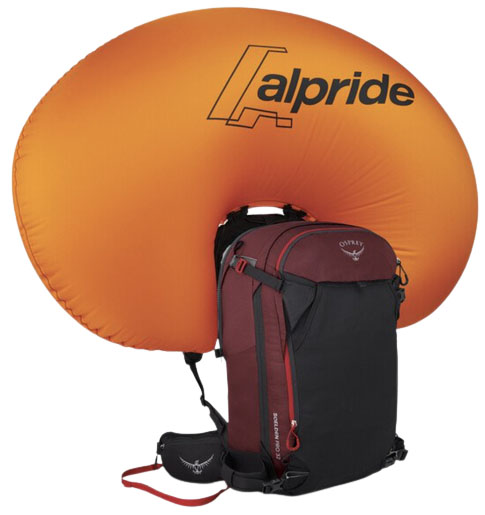 Category: Electric fan (supercapacitor)
Category: Electric fan (supercapacitor)
Weight: 6 lb. 6.5 oz.
Capacity: 32L
What we like: A backpack and airbag unit from two companies at the top of their game.
What we don’t: Backpack design needs improvement.
Osprey is a giant in the hiking and backpacking world, but they’ve made a big push in the snow market as of late. Their flagship piece is the Soelden Pro 32, which received a notable revamp last season. The newest Soelden Pro combines Osprey’s well-known build quality with the supercapacitor-powered Alpride E2 system (the same technology used by the BCA Float E2-35 above), a best-in-class airbag system and one of the lightest and most user-friendly designs available. The Alpride system is also removable, giving you the versatility to use the backpack whether or not you’re headed into avalanche terrain.
We’re big fans of Osprey packs, so we were disappointed to see that the Soelden Pro pack falls short in a number of ways. First off, its organization is middling: There’s no external accessory pocket, and you have to undo the compression straps to access the avy tool compartment. In terms of comfort and support, the floppy backpanel does not provide much support when the pack is loaded down, and the metal waistbelt buckle is painfully difficult to adjust. And at $1,400, it doesn’t help that the Soelden Pro is one of the priciest Alpride E2 packs here. We’re hopeful that Osprey will make adjustments in future iterations, but for now we’ll stick with the more refined designs above.
See the Men's Osprey Soelden Pro 32 See the Women's Osprey Sopris Pro 30
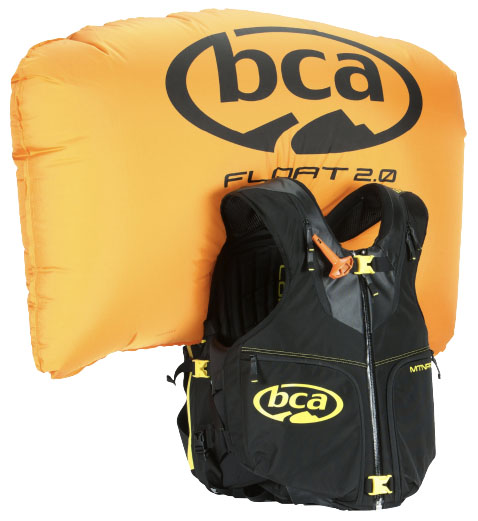 Category: Canister (compressed air)
Category: Canister (compressed air)
Weight: 8 lb. 0.8 oz.
Capacity: 20L (15L for the size S)
What we like: A sledding-specific design with added impact protection.
What we don’t: Expensive for a canister airbag.
The picks above are all designed for skiers and snowboarders, but we’d be remiss not to include at least one snowmobiling-focused model here. In general, sledders prefer vest-style packs with smaller capacities, external shovel carry (sledders often need quick access to a shovel to dig out their rig), and reliable protection from obstacles like trees or handlebars. The BCA Float MtnPro is one of the most popular vests among sledheads, revered for its durability, snug-fitting design, and time-tested Float 2.0 airbag design. It also adds a foam-wrapped hardshell for impact protection to the front, back, and sides of the vest, which makes a lot of sense given the added variables and speed associated with snowmobiling.
For the 2024 season, BCA also released the Float E2 MtnPro Vest, which features the supercapacitor-powered Alpride E2 system in addition to more refined storage, an internal frame sheet, and a more breathable backpanel. This pack retails for a stout $1,500, but serious sledders will appreciate the smooth-operating Alpride E2 airbag, which functions reliably in the cold (compared to some battery-powered designs) and relieves you of the rigamarole of dealing with air canisters. Regardless of the version you choose, it’s hard to go wrong with BCA, which is known for their reliable performance and reasonable price points.
See the BCA Float MtnPro Vest 2.0
| Airbag Pack | Price | Category | Weight | Capacities | Removable Airbag |
|---|---|---|---|---|---|
| Black Diamond JetForce Pro 25L | $1,500 | Fan (battery) | 6 lb. 7 oz. | 10, 25, 35L | No |
| Mammut Pro 35 Removable Airbag 3.0 | $1,005 | Compressed air | 5 lb. 13 oz. | 35, 45L | Yes |
| Backcountry Access Float 22 2.0 | $750 | Compressed air | 6 lb. 2 oz. | 12, 22, 32, 42L | No |
| Black Diamond JetForce UL | $970 | Compressed gas | 4 lb. 6 oz. | 26L | Yes |
| Backcountry Access Float E2-35 | $1,300 | Fan (supercapacitor) | 6 lb. 3 oz. | 25, 35, 45L | Yes |
| Ortovox Avabag Litric Tour 30 | $1,300 | Fan (supercapacitor) | 5 lb. 5 oz. | 30, 40L | No |
| Mammut Free 22 Removable Airbag 3.0 | $865 | Compressed air | 4 lb. 15 oz. | 15, 22, 28L | Yes |
| Scott Patrol E1 30 | $1,150 | Fan (supercapacitor) | 5 lb. 14 oz. | 22, 30, 40L | Yes |
| Osprey Soelden Pro 32 | $1,400 | Fan (supercapacitor) | 6 lb. 7 oz. | 32L | Yes |
| BCA Float MtnPro Vest 2.0 | $1,000 | Compressed air | 8 lb. 1 oz. | 20L | No |
*Editor's note: prices and weights include batteries/canisters.
Integrated into a ski backpack or vest, an avalanche airbag system is comprised of an airbag and power source (either a canister of compressed air or gas or an electric fan). When a skier (or snowboarder, sledder, etc.) pulls the attached handle, the airbag inflates to about 150 liters around and behind her torso. In the event of a slide, the inflated airbag keeps the skier at or near the surface of the snow thanks to a process known as granular segregation (i.e. in a mixture, larger objects are more likely to stay at the top while smaller objects sink down). In other words, it’s less about buoyancy, and more about increasing the size of the skier. Thus, whereas an avalanche beacon is an important piece of gear to have in the event that you (or your partner) are buried, an avalanche airbag increases your odds of not getting buried in the first place.
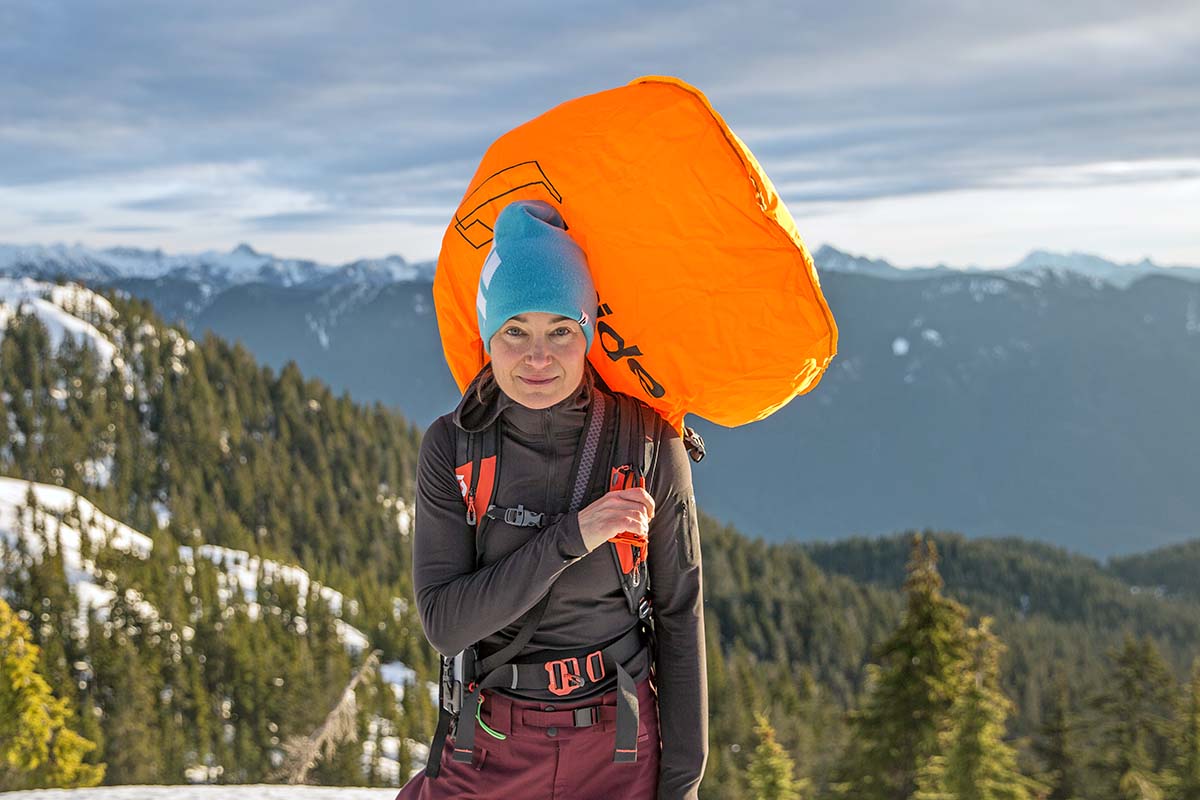
Good research into the field of avalanche airbags is hard to come by, which is unsurprising given that they’ve only become popular in the last decade or so. And as with all avalanche science there are a number of human factors at play: For example, in many cases an airbag might offer an illusion of safety, thus actually increasing the likelihood of traveling in avalanche terrain. All factors aside, there’s no denying the efficacy of an airbag in the event of a slide, and one well-known 2014 study found a reduction in the overall mortality rate from 22 (without an inflated airbag) to 11% (with an inflated airbag). In the end, if you’re going to be skiing in high-consequence terrain, an airbag backpack is a valuable piece of equipment.
In general, there are two main types of avalanche airbags: those that inflate via a canister filled with compressed air or gas, and those powered by an electric fan. Canister-powered airbags differ from electric designs in a number of ways, including weight and packed size, convenience, price, ability to travel, and more. Thus, when deciding on which airbag is right for you, the type of power source will be one of your first considerations.
Canister Airbags
In a canister system, compressed air or gas is held under pressure in a cylinder (usually made of aluminum) via a thin metal disc or O-ring valve. When the handle is pulled, the air or gas is released into the airbag, inflating it to its maximum capacity. Airbags like the BCA Float 2.0 use compressed air, while setups like the popular Alpride 2.0 (seen in Black Diamond’s JetForce UL) use a two-canister compressed gas system (one filled with argon and the other with carbon dioxide). Compressed gas cylinders are substantially smaller and lighter and are certified for international airline travel (however, the TSA does not allow gas cylinders on US-based flights), but they’ll usually run you about $70 for a set of two. On the other hand, the major benefit to compressed air is that the cylinders can be refilled by visiting an authorized refill location (this will cost you roughly $20) or with a high-pressure pump (like the Benjamin High Pressure Hand Pump).
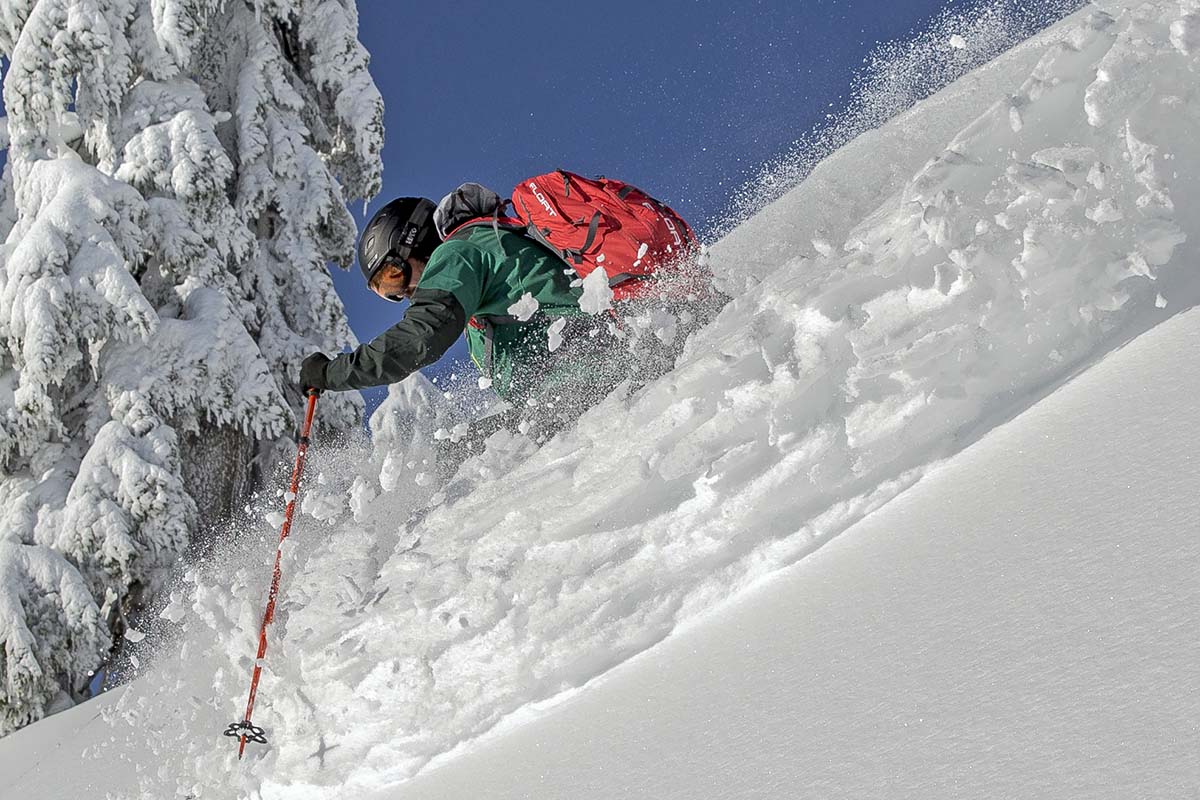
Canister-powered systems used to dominate the market, but it’s been awhile since we’ve seen innovation in this realm. At the same time, electric systems just keep getting lighter, more compact, and easier to use. That said, the most obvious benefit to canister airbags is price: Packs like the popular Mammut Pro 35 Removable Airbag 3.0 will cost you $1,105 all in (the BCA Float 22 2.0 is even more affordable at $750 total), while electric airbags start around $1,300. In addition, their mechanical nature means canister systems require very little maintenance and don’t need to be charged or powered on/off. But the downsides are many. As we outline below, canister-powered airbags are generally a bit heavier (with the exception of compressed gas), aren’t easy to practice with (you’ll blow through your air or gas), don’t allow for multiple deployments or continuous deployment (helpful if your airbag gets punctured), are inconvenient to refill, and are not compatible with air travel (in the U.S.).
Pros:
Cons:
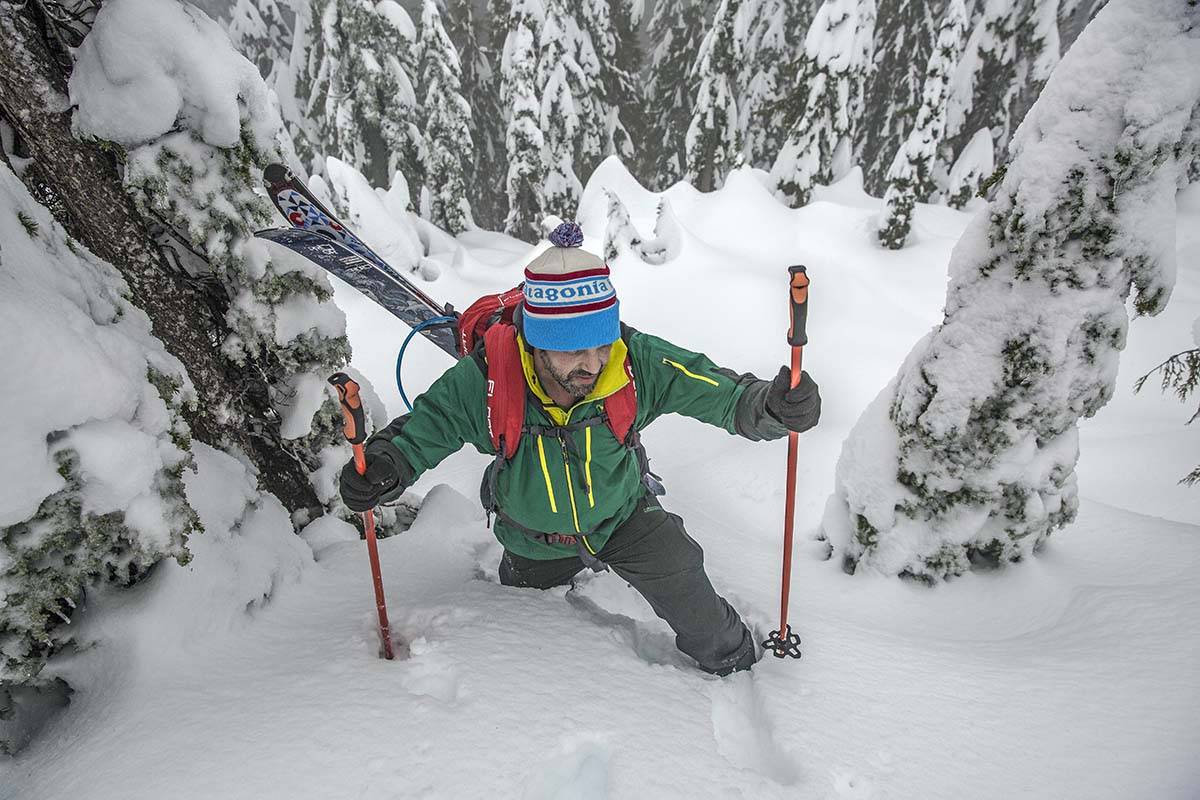
Electric Airbags
Electric airbags use a high-speed fan to pull air into the airbag and are powered either by a battery or a supercapacitor (which itself is powered by a battery). Both of these systems require you to charge the unit and power it on before use. Airbags like the Black Diamond JetForce Pro use a battery to power their fan, whereas the new Alpride E2 and Litric systems employ a supercapacitor. Supercapacitor- and battery-powered fans vary in terms of weight (supercapacitors are lighter) and lifespan: Batteries have enough charge to continuously fill an airbag (helpful in the case that an airbag is punctured) and can inflate an airbag multiple times in one charge. On the other hand, supercapacitors only hold enough charge for a few practice deployments, although the Alpride system can be recharged in the field with two AAs.
It’s no surprise that electric airbags have caught on, as they are superior to canister-powered airbags in a number of ways. First and foremost, you just can’t beat the ability to practice without churning through air cylinders or gas cartridges, and we’d much rather service our airbag by simply plugging it into the wall rather than having to find a place to refill a canister (or buy new gas cartridges). Second, the option for continuous deployment (keep in mind, this is only possible with battery-powered fans) can be extremely valuable if your airbag is ripped during a slide. And finally, electric airbags are practically a non-issue when it comes to air travel (larger lithium-ion batteries might need airline approval and must be placed in a carry-on), meaning that you don’t have to hassle with emptying your air cylinder or find a place to acquire compressed air or gas at your destination.
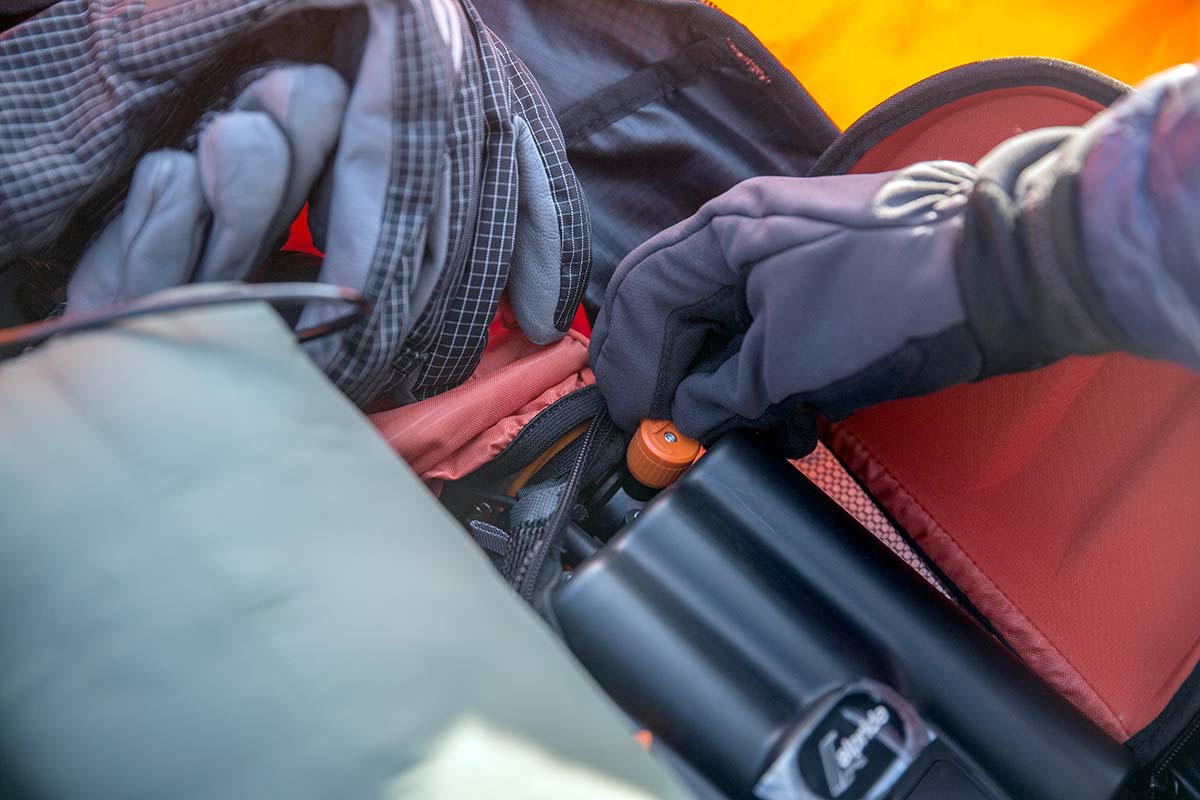
Of course, there are a few reasons why electric airbags haven’t completely taken over the market. For one, they are expensive. The Black Diamond JetForce Pro will run you $1,500, while BD’s canister airbag (the JetForce UL) is available for just $900 (plus $70 for cartridges). Second, there’s simply more that can go wrong with an electric design: You’ll want to keep your battery charged, the system updated (the JetForce Pro is Bluetooth-compatible), and remember to turn your airbag on at the beginning of each ski day. There’s also the issue of cold temperatures affecting batteries, although this has been largely resolved in recent years. Supercapacitor-powered systems are arguably the most refined and require very little maintenance in terms of charging, turning on and off (BCA actually recommends that users leave the Float E2's Alpride system on all season), and updating.
Pros:
Cons:
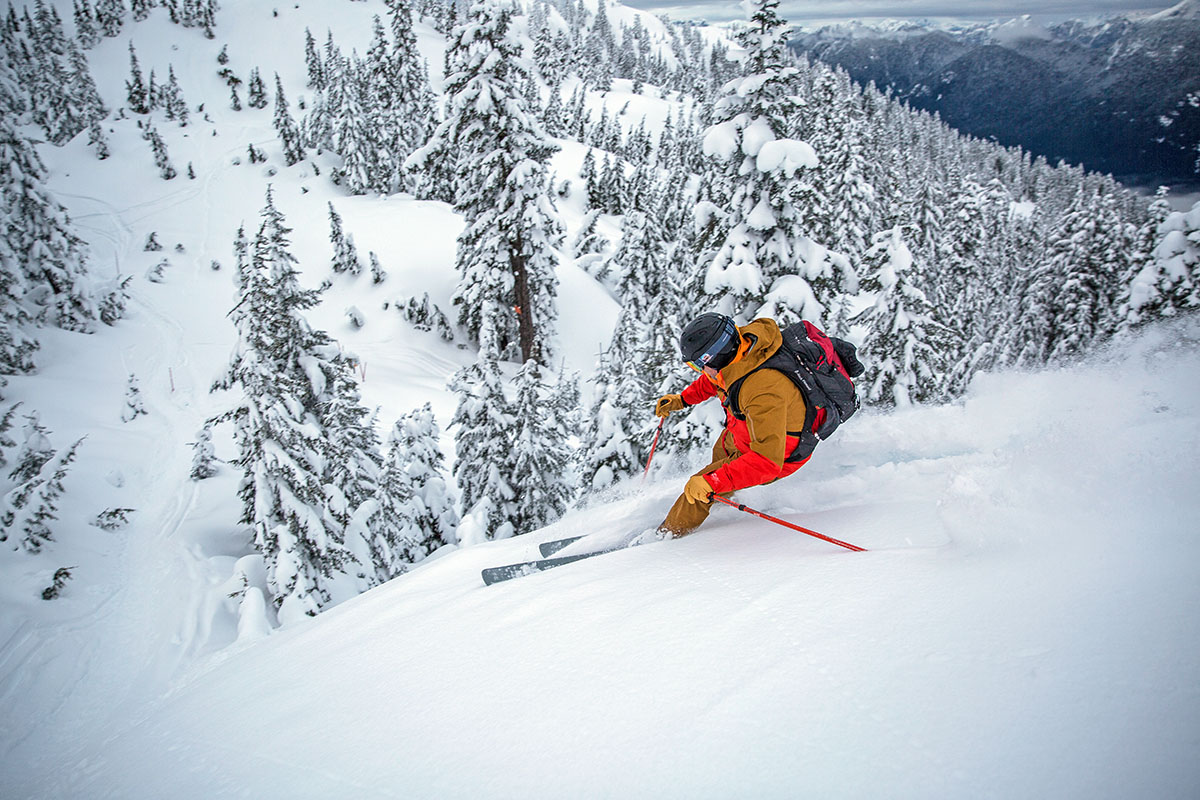
The airbag backpacks on our list range in weight from 4 pounds 6 ounces for the Black Diamond JetForce UL to 8 pounds 1 ounce for the BCA Float MtnPro Vest 2.0. In general, you can expect airbags powered by gas cylinders to weigh the least, followed by most modern supercapacitor- and battery-powered systems. The majority of compressed air-powered airbags fall on the heavy end of the spectrum. For example, the Alpride 2.0 airbag unit seen in the JetForce UL (which uses compressed gas) weighs 1 pound 8.3 ounces, while the Litric system (supercapacitor) tips the scales at 2 pounds 6.1 ounces. Moving up, the Black Diamond JetForce Pro (battery) clocks in at 2 pounds 7 ounces, the Alpride E2 (supercapacitor) is 2 pounds 10 ounces, and the Mammut Removable Airbag System 3.0 (compressed air) is the heaviest of the bunch at 3 pounds 1.4 ounces (these weights all include canisters when applicable).
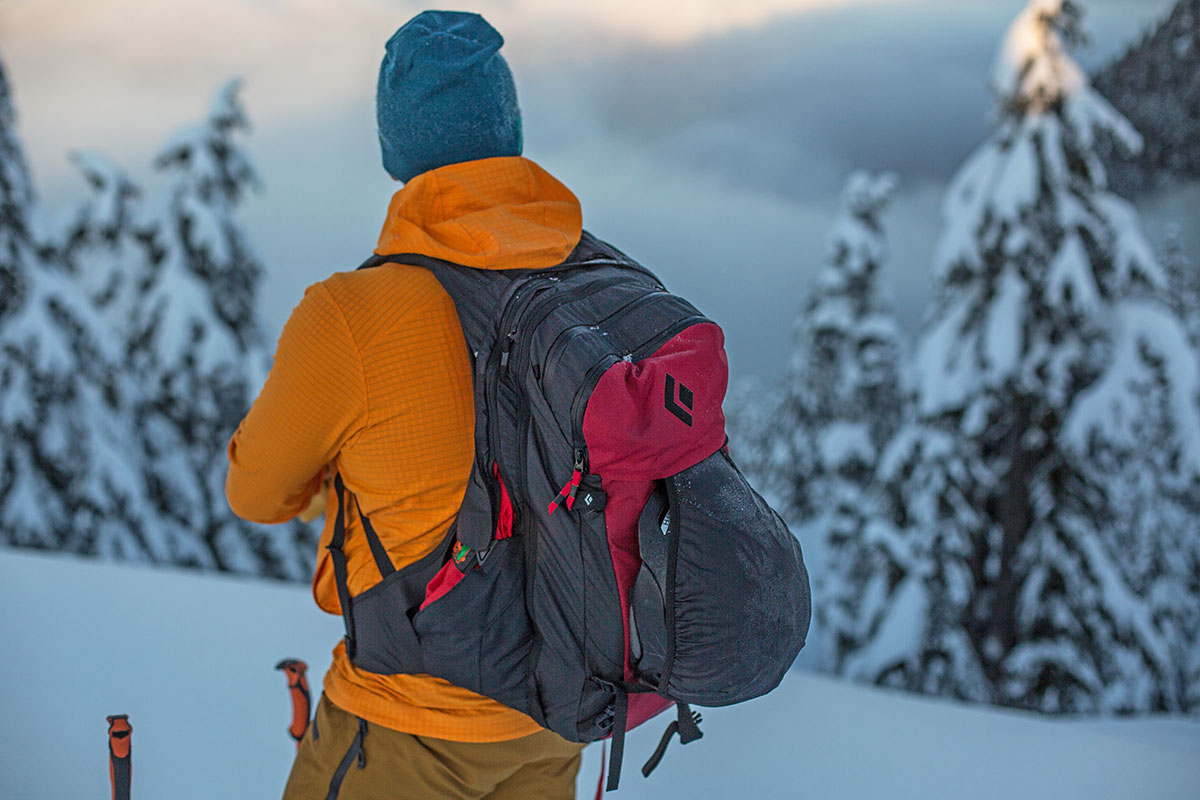
Regardless of your style of skiing (heli or cat-accessed, ski mountaineering, etc.), weight will be a factor in your purchasing decision. Anecdotally, on a hut trip in British Columbia’s Valhalla mountains a few winters back, one of our ski partners repeatedly left his Black Diamond Halo (a now discontinued electric airbag system that weighs 7 lb. 8 oz. all-in) at the lodge because it was “just too heavy.” If getting a lighter airbag pack means you’ll use it more often, we’d say it’s well worth it.
Most airbag backpacks range in capacity from about 20 to 35 liters. For heli- or cat-powered laps, skiers and snowboarders can get away with a smaller model (in the 20-liter range) for toting the bare essentials: avy tools, water and snacks, and perhaps a layer. If you’re earning your turns, you’ll likely want to bump up to a 25 or 30-liter pack to accommodate extra layers, skins, and food and water for the entire day. Finally, for overnight ski mountaineering missions (such as the hut-to-hut Haute Route), a 35-liter pack is your best bet. The good news is that most brands offer the same airbag technology in a range of capacities, so it’s easy to find the right pack for your needs.
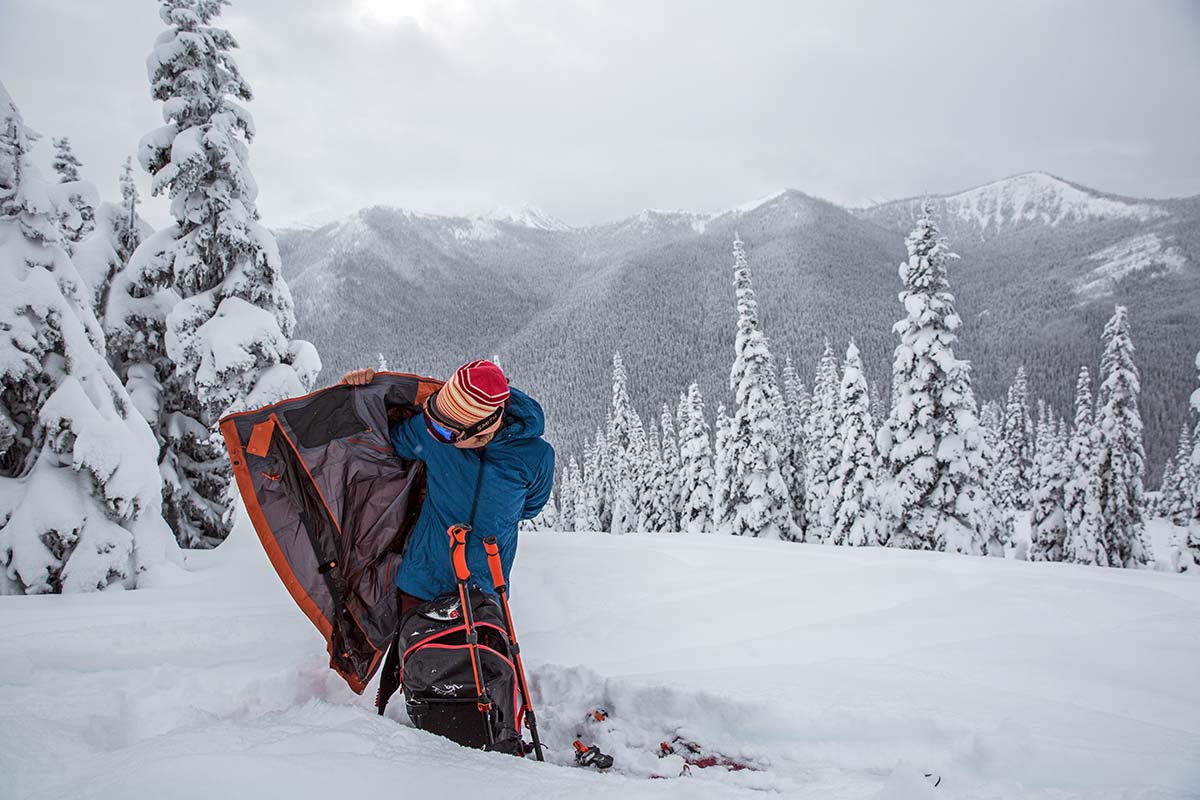
The ability to customize capacity is one of the biggest selling points of interchangeable airbags (for more on this, see below), which can be swapped between packs of varying capacities. Mammut's Removable Airbag System is a great example, which features an interchangeable airbag that can be used in any of their packs. And then there’s Black Diamond’s modular JetForce Pro, which allows you to attach a 10, 25, or 35-liter “Booster” to the JetForce Pro unit (Ortovox's new Litric Tour and Freeride series offer similar customization). Given that a skier’s carrying capacity needs can vary a great deal depending on the day, this is an innovative solution and one we hope to see more of in the years to come.
Finally, in our discussion of capacity it’s also important to factor in the volume of the airbag unit. An airbag unit—including the packed airbag and power source—will take up roughly one to two liters of space within your backpack, which sounds small but in practice is not insignificant. Supercapacitors and gas-cylinder systems are the most compact options (the Alpride E2 has a listed volume of 1.2L), while batteries and compressed air canisters are on the bulky side. Most backpacks will come with a section particularly designed for the airbag unit, and we prefer those that place it towards the bottom (not directly in the middle, as is the case with the Scott Patrol E1). Regardless of the airbag unit’s size and placement, chances are you’ll be tweaking your packing system slightly to accommodate for the extra bulk.
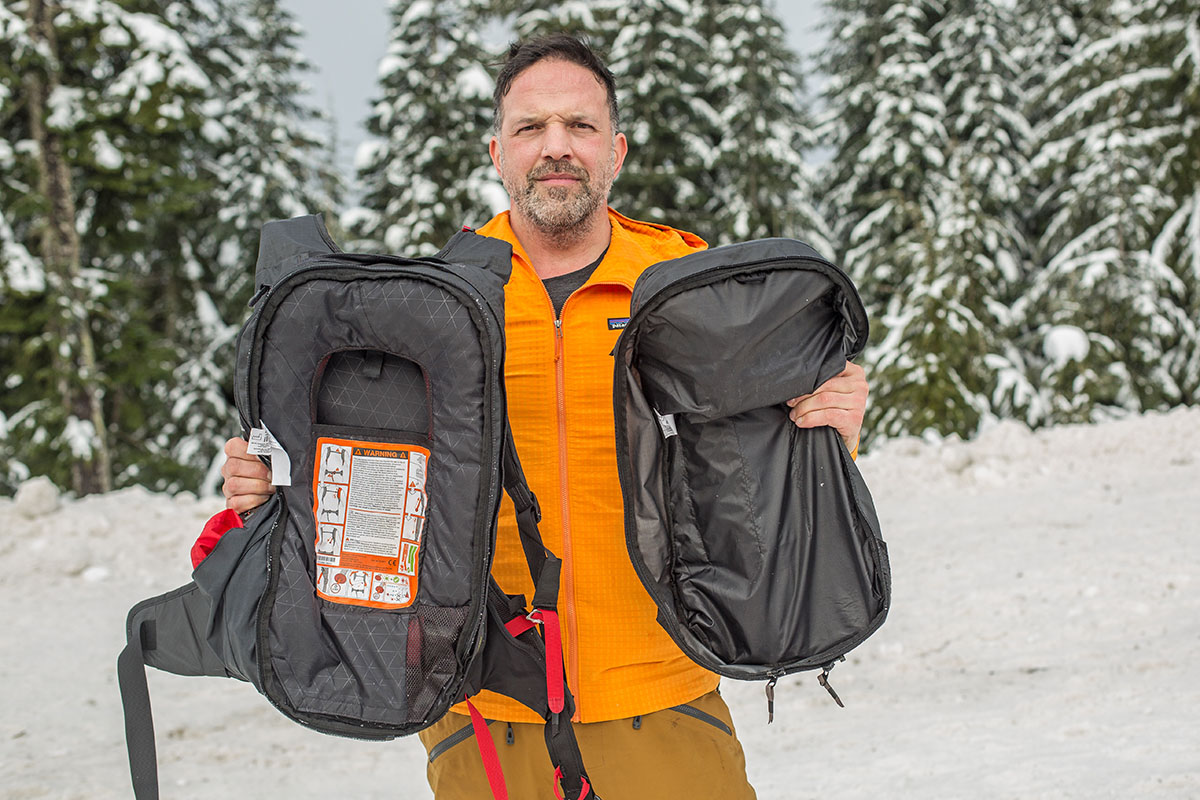
For all this talk about airbags, it’s worth remembering that you’ll be purchasing a backpack along with the airbag unit. Airbag backpacks range in size from about 20 to 35 liters and are similar in most ways to standard ski backpacks. Look for a dedicated avy tool pocket, ski (or snowboard) attachment, helmet carry, multiple access points to the main compartment, and more (for a complete breakdown of ski backpack features, check out our article on the best ski backpacks).
Airbag backpacks will also have a few specific features that set them apart. First, they all have a dedicated space that holds the airbag unit in place (many airbag units are fixed, while others are removable). Second, every airbag backpack will feature a zippered sleeve on one or both shoulder straps—this is where the airbag handle extends (similar to a hydration reservoir hose). Finally, attached to the back of the hipbelt you’ll find a leg-loop strap that extends through your legs and to the front of the hipbelt, ensuring that your pack stays on your body in the event of a slide.
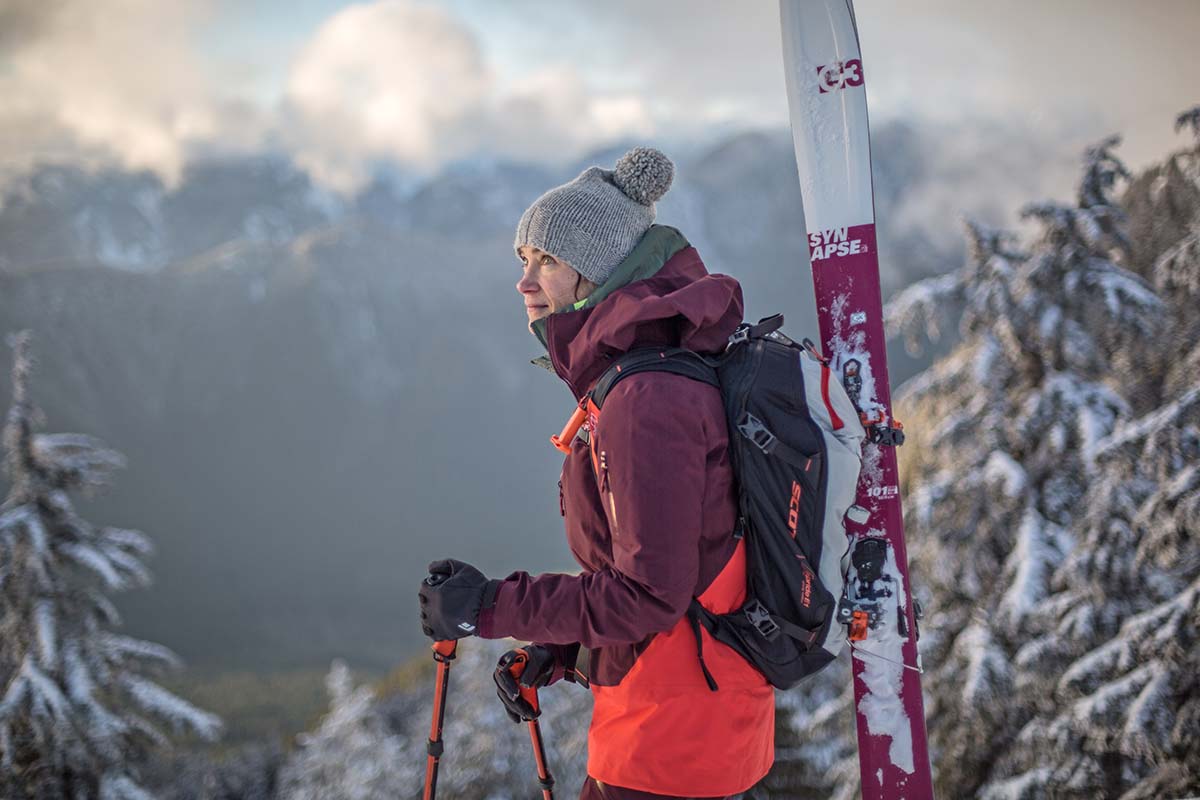
An ill-fitting backpack will be a bear to carry, and this is especially true for airbag packs given their inherently heavy design. Further, airbag packs lack the adjustment range of standard backpacking packs, so you’ll want to make sure you purchase the right size (trying on before you buy is a good idea) and adjust the pack properly each time you put it on (our backpack fit and sizing guide can help). It should come as no surprise that we have a strong preference for packs that come in multiple sizes—the Black Diamond JetForce Pro, for example, is available in S/M and M/L, while Osprey's airbag pack comes in both men's (Soelden Pro 32L) and women's (Sopris Pro 30L) versions. On the other hand, a one-size-fits-all pack like the Mammut Pro 35 either fits or it doesn’t, which will be a deal breaker for many.
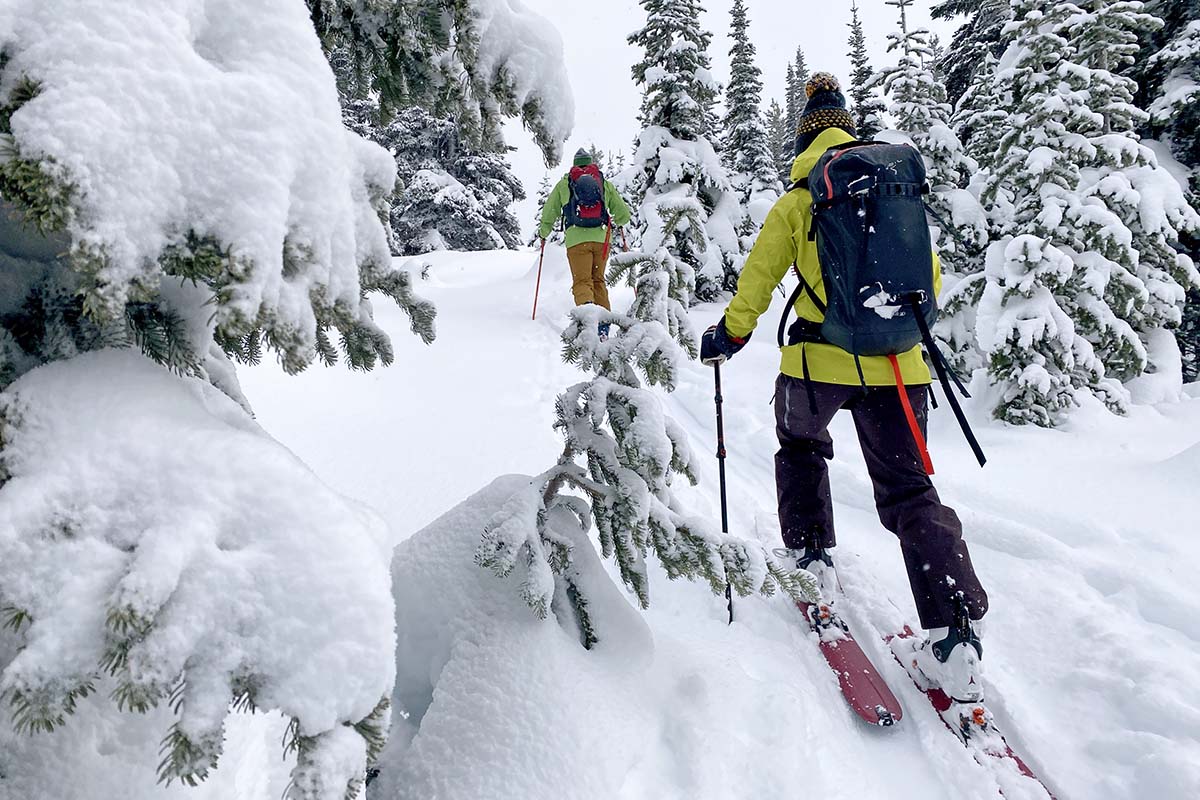
Many avalanche airbags are sold as all-in-one systems, meaning that the airbag you purchase can only be used with the included backpack. However, a few models—namely the Alpride E1/E2 and 2.0 and the Mammut Removable Airbag System 3.0—are more widely used and have been adapted by brands like Black Diamond, Dakine, Scott, Osprey, Highmark, Deuter, and more. These airbags can be purchased as standalone items or as part of an all-in-one system and then swapped between compatible backpacks. Keep in mind that a removable airbag must be paired with a pack specifically designed for use with that airbag—any other combination is unsafe and could result in equipment failure.
Most of us won’t be purchasing an airbag unit and backpack separately, but the option can come in particularly handy if you want to swap your airbag between packs of varying capacities. For example, perhaps you purchased the Mammut Pro 35 with the Removable Airbag System (RAS) 3.0 installed, but want a 22-liter pack for sidecountry days. For another $240, you can purchase Mammut's Free 22 "Airbag Ready" pack (without an airbag unit), move the RAS over, and have a second airbag pack for a fraction of the cost. Interchangeable airbags also allow you the versatility of using your pack without the airbag on particularly low-risk days (models like the Black Diamond JetForce Pro are not meant to be removed from their pack). In the end, for those who float between disciplines, interchangeable airbags offer the most versatility and bang for your buck.
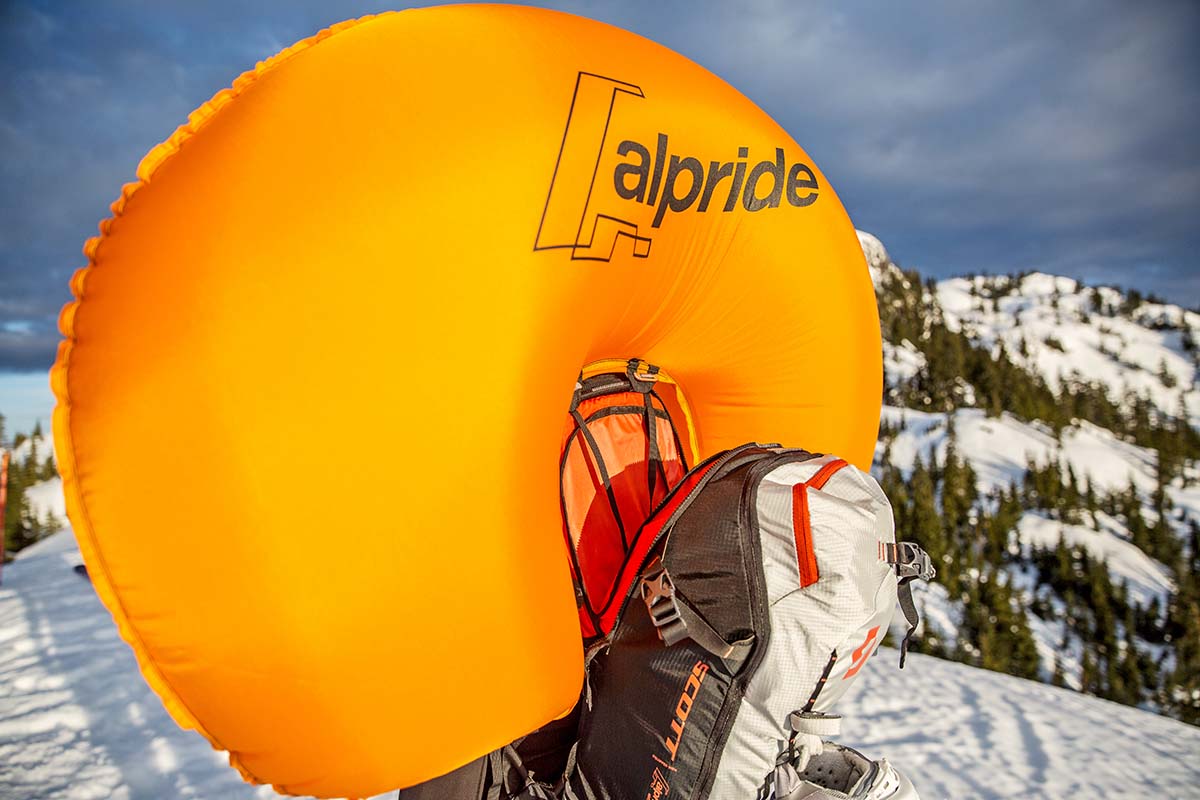
Not all skiers will travel via air to their ski destinations, but those who do will need to make special considerations for their airbag backpack. We’ll get the good news out of the way first: airbags powered by supercapacitors or batteries are good to go for air travel, either in a carry-on or checked baggage (your airline might ask you to separate the lithium-ion battery from the unit and place it in your carry on). If you plan on flying a lot to ski, these are by far the most convenient option.
The issue is a bit more complicated for canister airbags: compressed air is a no-no according to the TSA, so if your travels begin in the U.S. (or you’ll be going through security in the U.S.), you’ll need to empty your canister before flying. For the sake of clarity, it’s best to show the canister is empty by removing the top completely, and pack it in your carry-on so airline security can see that it’s empty without rifling through your bags. Interestingly, the International Air Transport Association has made special accommodations for canister airbags, but this is only applicable to non-U.S. travel (we've found this article from BCA useful). Compressed gas is a bit more complicated: The TSA permits compressed gas for items like cordless curling irons, inflatable life jackets, and air guns, but does not state any exceptions for airbags. In the end, it’s not a guarantee you’ll be able to transport the gas cylinder.
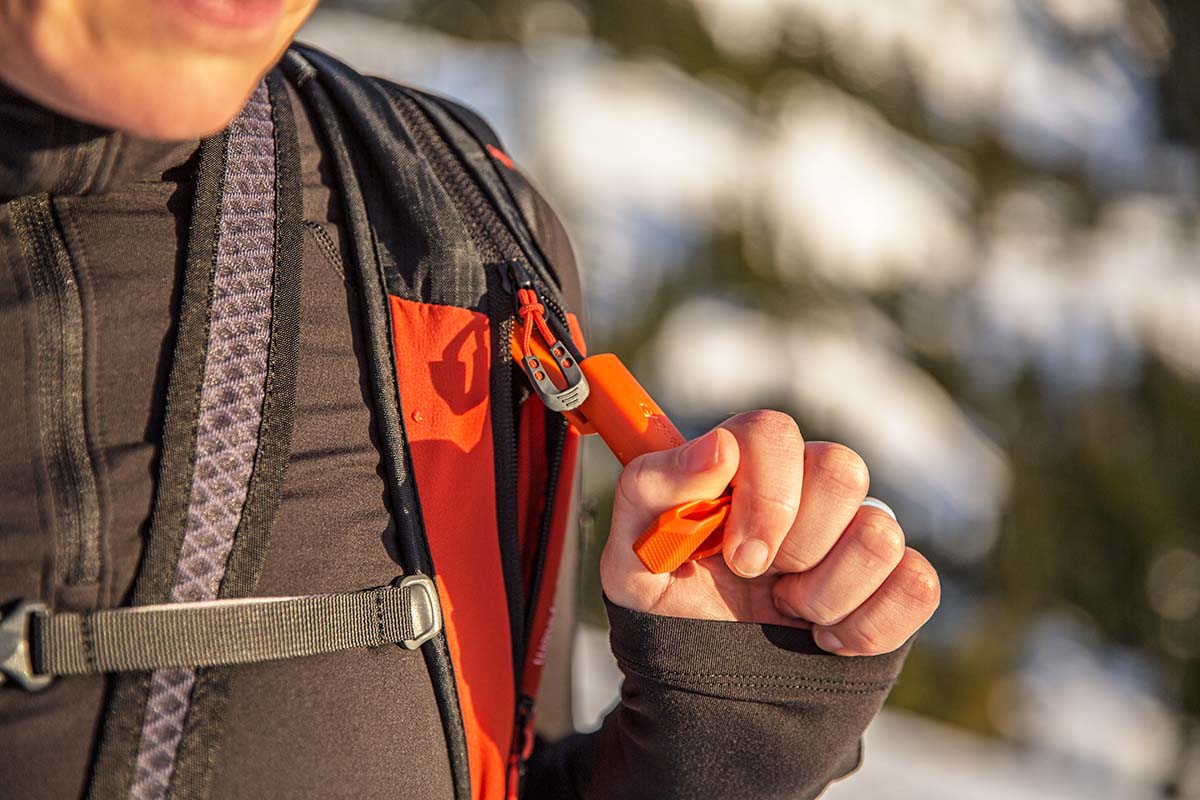
If you do choose to travel with your canister-powered airbag, you’ll have to find a way to fill your canister (or purchase compressed gas cylinders) at your destination. While far from impossible, this is an extra task that you’ll have to manage upon arrival in a new country, and the major reason we recommend electric airbags for international travel. The good news is that if you’re headed to a ski resort or major town nearby, it shouldn’t be too hard to find somewhere to refill (or exchange) your canister, and in many places you can even rent a canister. We’ve found BCA’s Cylinder Refill/Exchange Locator to be a helpful resource.
Airbags are built for cold, whether they’re powered by compressed air/gas or an electric fan. The majority of airbags on our list function in temperatures as low as -22˚ Fahrenheit (including the battery-powered BD JetForce Pro, the supercapacitor-run Ortovox Litric Tour, and canister models like the Mammut Pro Removable Airbag 3.0). That said, if you’re skiing in extremely cold temperatures, it can be a good idea to keep your battery or canister well insulated (wrap it in a down jacket and keep it close to your back, for example) and monitor your system throughout the day. Cold temperatures can also cause batteries to drain more quickly than usual, so you’ll want to monitor power levels in between tours.
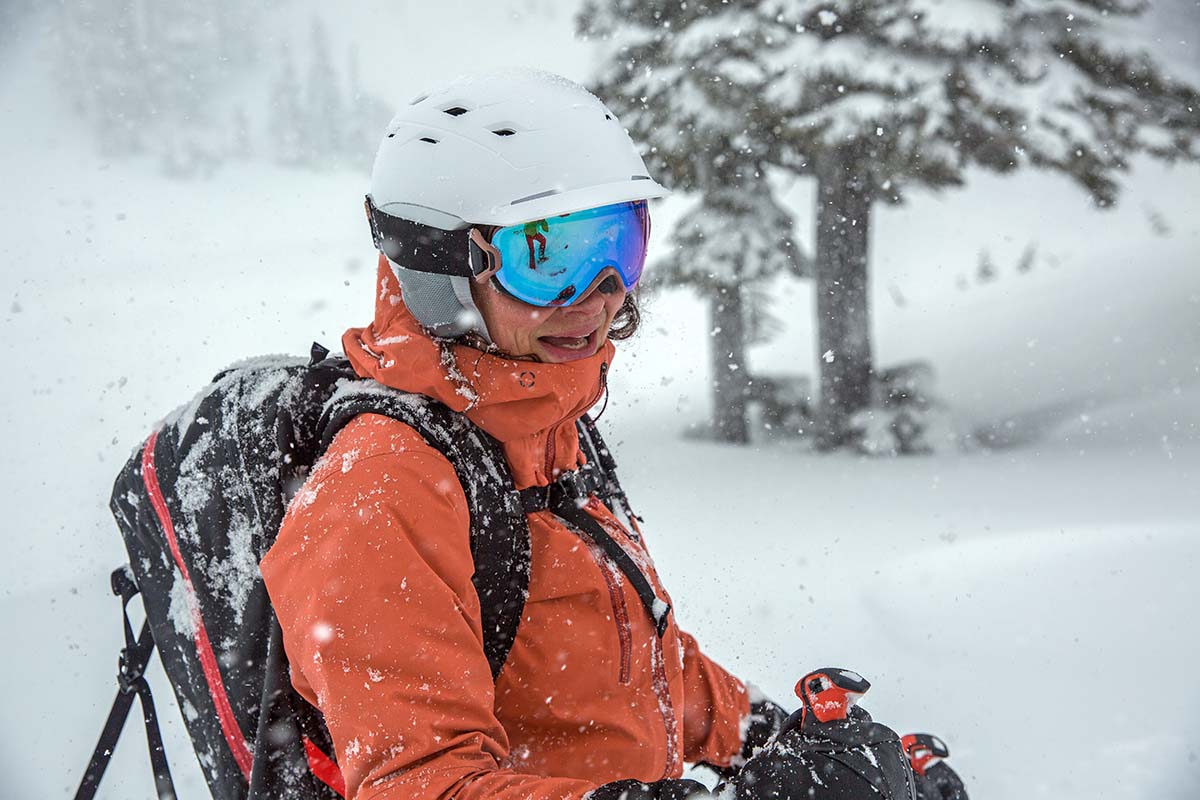
Despite their steep price tags, avalanche airbags are not a lifetime purchase. Most airbags have a stated life of 40 to 50 deployments, or about 5 years of regular use. Across the board, manufacturers recommend that airbags be retired 10 years after the date of purchase. There are a few steps you can take to prolong the life of your airbag: manufacturers recommend deploying it at least once per year, and always allow it to dry out completely before repacking (see below for more storage tips). And we do recommend performing routine checks on your system, including assessing the airbag, wiring and fan (if applicable), deployment handle, and backpack suspension.
It’s unlikely you’ll be putting your airbag to use 12 months out of the year, so you’ll want to make sure you store it well in the off-season. In general, airbags should be kept in cool environments (around room temperature), out of direct sunlight, and away from heat sources or moisture. Battery-operated packs should be disarmed and put into storage mode (check your user manual for instructions) and stored with roughly 75% battery life. If your airbag uses a canister, be sure to remove it before long-term storage. Finally, when bringing your equipment out of storage at the beginning of the season, you’ll want to fully charge your batteries and check the pressure gauge on your compressed air canister, as air can leak over time. If you can, it’s even best to fully deploy your airbag to make sure it’s in working condition.
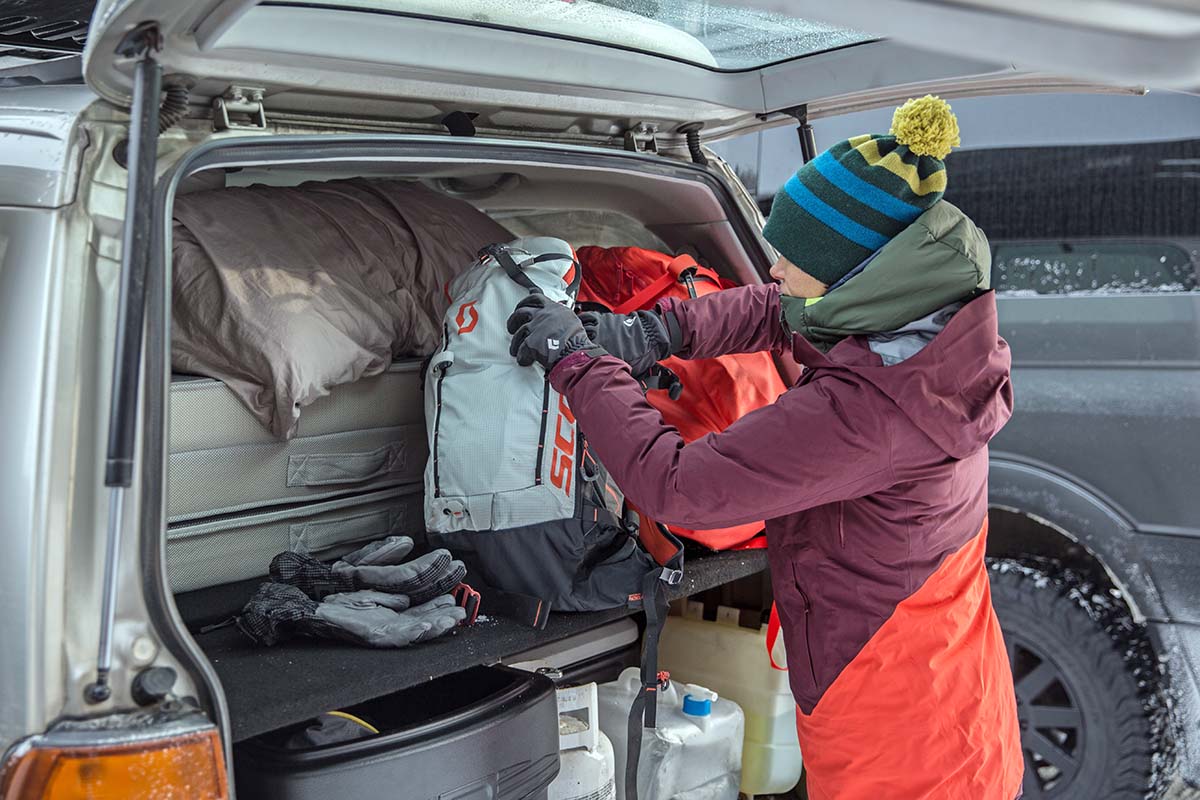
Chances are, if you’re purchasing an avalanche airbag you’re well versed in avalanche terrain and rescue. Regardless of your level of experience, we recommend that everyone traveling into the backcountry in the winter take an avalanche safety course, for their own safety and the safety of their partners. The American Institute for Avalanche Research and Education (otherwise known as AIARE) is the industry standard for avalanche education, offering a series of classes for both recreational and professional learners. If you need a place to start, check out their 1-day Avalanche Rescue Course or 3-day AIARE 1. And of course, before you head out each day, you’ll want to check in with your partners to make sure they’ve refreshed their knowledge and are prepared to act in the event of a slide (always do a beacon check as well).
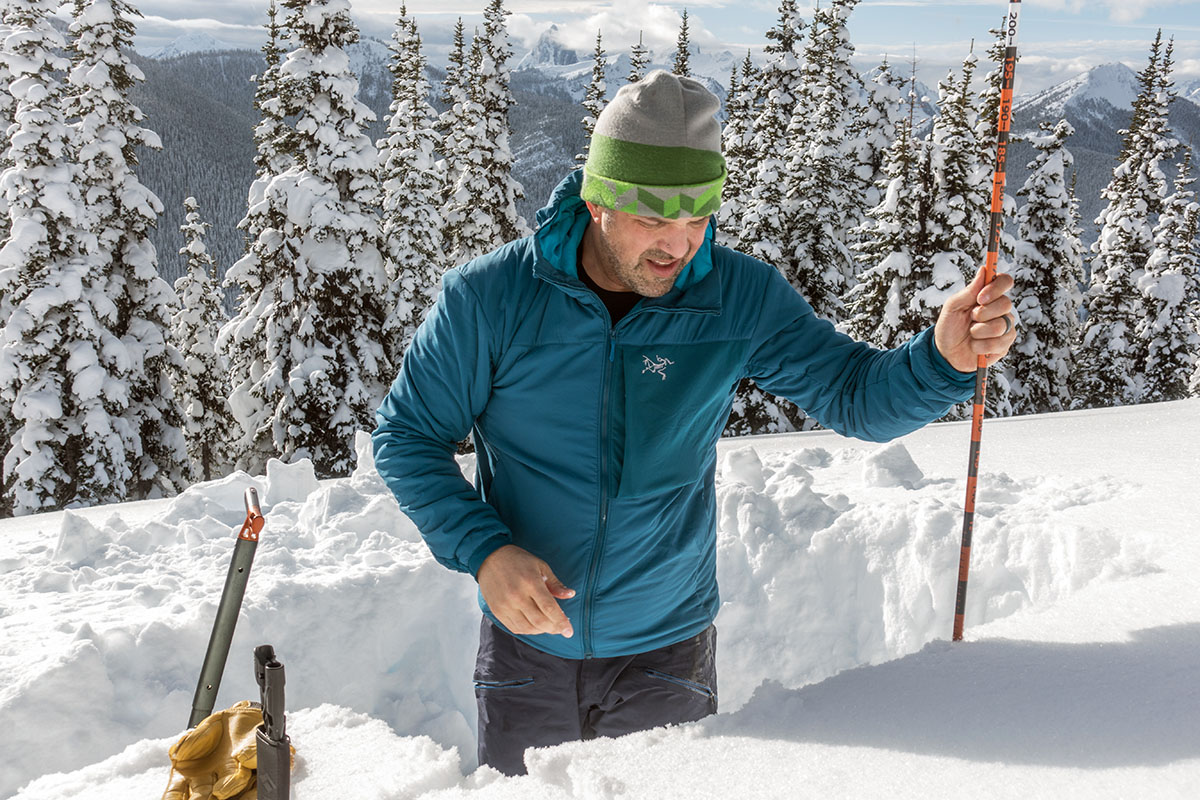
An avalanche airbag is a great tool for intermediate and advanced skiers who often find themselves in avalanche terrain. However, it by no means is a replacement for your avalanche rescue toolkit, which includes a beacon, shovel, and probe (along with the knowledge of how to use them). In terms of clothing and equipment, we’ve compiled in-depth lists for everything you need to hit the slopes, including backcountry skis and boots, ski helmets and goggles, ski jackets and pants, and even climbing skins (perhaps our backcountry skiing checklist is the best place to start). And if you’re not yet sold on your need for an avalanche airbag backpack, check out our list of standard ski backpacks for a deep dive into the market.
Back to Our Avalanche Airbag Pack Picks Back to Our Airbag Pack Comparison Table